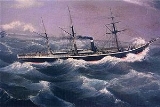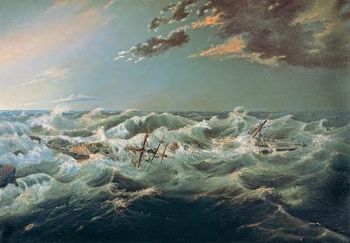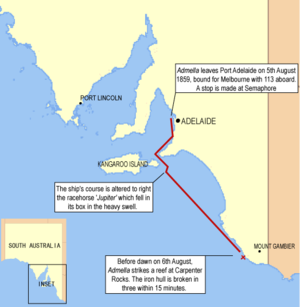
SS Admella
Encyclopedia
Reef
In nautical terminology, a reef is a rock, sandbar, or other feature lying beneath the surface of the water ....
off the coast of Carpenter Rocks, south west of Mount Gambier
Mount Gambier, South Australia
Mount Gambier is the largest regional city in South Australia located approximately 450 kilometres south of the capital Adelaide and just 17 kilometres from the Victorian border....
South Australia
South Australia
South Australia is a state of Australia in the southern central part of the country. It covers some of the most arid parts of the continent; with a total land area of , it is the fourth largest of Australia's six states and two territories.South Australia shares borders with all of the mainland...
, in the early hours of Saturday 6 August 1859. Survivors clung to the wreck for over a week and many people took days to die as they glimpsed the land from the sea and watched as one rescue attempt after another failed.
With the loss of 89 lives, mostly due to cold and exposure, it is one of the worst maritime disasters in Australian history. The Admella disaster remains the greatest loss of life in the history of European settlement in South Australia. Of the 113 on board there were only 24 survivors, including only one female, Bridget Ledwith. Of the 89 dead, 14 were children. The 150th anniversary of the disaster was marked in August 2009 by events across the south east of South Australia and at Portland
Portland, Victoria
The city of Portland is the oldest European settlement in what is now the state of Victoria, Australia. It is the main urban centre of the Shire of Glenelg. It is located on Portland Bay.-History:...
, Victoria
Victoria (Australia)
Victoria is the second most populous state in Australia. Geographically the smallest mainland state, Victoria is bordered by New South Wales, South Australia, and Tasmania on Boundary Islet to the north, west and south respectively....
.
SS Admella
The SS Admella (so named for her circuit Adelaide, Melbourne, Launceston) was built by Lawrence Hill and Co. at Port Glasgow, Scotland in 1857. She was an iron single screw steamer nearly 60 metres long and 8 metres at her widest and displaced about 395 tons. At the time she was one of the fastest and most luxurious ships on the Australian intercolonial trade routes. On the regular Adelaide-Melbourne run her fastest voyage had once been made in 42 hours.In 39 voyages between Adelaide and Melbourne there had never been cause for alarm aboard the Admella. Never any need for life boats or life belts. The vessel's only captain, Hugh McEwan was a cautious and capable master mariner. Admella had been constructed with water-tight bulkheads, riveted to the hull. These were designed as a special safety feature, but were ultimately the cause of a catastrophic break up of the ship into three exposed sections in the first 15 minutes of the disaster.
Doomed voyage
Under the command of Captain Hugh McEwan Admella left Port Adelaide for what was to be her final trip early on Friday, 5 August 1859, on her usual run to Melbourne with eighty-four passengers and a crew of twenty-nine. Her cargo consisted of ninety-three tons of copper, flour for the Victorian goldfields, general merchandise, and four racehorses bound for the Melbourne CupMelbourne Cup
The Melbourne Cup is Australia's major Thoroughbred horse race. Marketed as "the race that stops a nation", it is a 3,200 metre race for three-year-olds and over. It is the richest "two-mile" handicap in the world, and one of the richest turf races...
. Due to the heavy swell, one of the horses fell over. To right it the ship changed course slightly, while the horse was put on its feet.
At four o'clock next morning, when the vessel was approaching the Cape Northumberland light, the captain believed himself to be far from land. In reality, however, the ship was close to a dangerous reef at37°52′47"S 140°21′3"E, probably from a current which carried the vessel shorewards.
Suddenly she grated on a reef and, keeling over, lay broadside on to the heavy seas. An effort was made to lower the boats
Lifeboat (shipboard)
A lifeboat is a small, rigid or inflatable watercraft carried for emergency evacuation in the event of a disaster aboard ship. In the military, a lifeboat may be referred to as a whaleboat, dinghy, or gig. The ship's tenders of cruise ships often double as lifeboats. Recreational sailors sometimes...
, but two of them were smashed and the third broke adrift. The swell lifted her further on to the reef, impelling her with such force that she lay on the summit of the ridge, with her starboard side high out of the water. In less than fifteen minutes the Admella broke into three parts and several passengers were washed overboard. A few rockets were discovered and fired in the hope of attracting the attention of lighthouse-keepers at Cape Northumberland, 25 km away, but they were damp and failed to ignite correctly. Meanwhile those on the wreck turned their eyes to seaward for assistance.
Daylight revealed a deserted coastline about 1 km away interrupted by raging surf, and plans were being formulated for an attempt to reach shore when a steamer was seen in the distance. Signals were hurriedly erected on the remaining mast and rigging, and the ship's bell rung, but the vessel, Admellas sister ship Havilah, passed without seeing them. On the second day the sea was calmer and two seamen, John Leach and Robert Knapman, succeeded in reaching the shore with the assistance of a raft. Exhausted, they hurried through the night to alert Cape Northumberland lighthouse.
Rescue efforts

Adelaide
Adelaide is the capital city of South Australia and the fifth-largest city in Australia. Adelaide has an estimated population of more than 1.2 million...
450 km north west and Portland
Portland, Victoria
The city of Portland is the oldest European settlement in what is now the state of Victoria, Australia. It is the main urban centre of the Shire of Glenelg. It is located on Portland Bay.-History:...
100 km east. The Corio left from Adelaide and the Ladybird from Portland but, due to poor information, both rescue boats had difficulty locating the now desperate Admella.
Meanwhile the wreck was battered by the heavy swell. Captain McEwan shared out what little food remained and had to prevent survivors from drinking salt water, which had begun to take the lives of those who drank it. Others, exhausted by their ordeal, simply slipped into the sea to their death. In the words of one lifeboat captain they were:
Over the next few days, several rescue attempts were made by the Corio and Ladybird rescue boats. Rockets were fired to try to get lines aboard but mountainous seas and severe winter storms drove the rescuers back and lives were lost as the lifeboats were swamped. A further attempt was made to launch one of Admella's own lifeboats, which had washed ashore, but it too was unsuccessful. By Saturday, one full week after the wreck, the Admella's lifeboat and the Corio's boat were launched from the beach and managed to crash through the surf and reach the wreck. Eventually three people made it onto one boat, which then capsized, drowning one man.
The Portland lifeboat which had been towed to the scene by the Ladybird had made an earlier attempt to reach the wreck but was driven back by the raging seas. Now it was finally successful in coming alongside the wreck and the remaining 19 survivors jumped and fell into the boat. They were transferred to the Ladybird which returned to Portland. The lifeboat is now housed in the Portland Maritime Museum.
Aftermath

For a few weeks crews who had participated in the rescue were treated as heroes, especially Captain Greig and the crew of the Ladybird. In the community, businesses and individuals raised money for the Admella Shipwreck Reward and Relief Fund for rescuers and survivors. Following the commission of inquiry into the wreck of the Admella, the loss was attributed to the effects of a current which pushed the vessel off course, although investigations were also held into a magnetic disturbance in the area which may have affected the compasses on iron hulled ships. The commission found that a contributing factor had been the way in which the watertight bulkheads had been inserted - the holes for the hundreds of rivets had weakened the metal. The inquest also resulted in the installation of the telegraph at Cape Northumberland and in 1881 a lighthouse was built at Cape Banks. Interestingly, nearly 100 years later a much larger ship The Corio came to grief on the very same reef and sank but with all onboard rescued.
The Admella wreck is protected under the Commonwealth Historic Shipwrecks Act 1976
Historic Shipwrecks Act 1976
The Historic Shipwrecks Act 1976 is an Australian Act of Parliament designed to legally protect historic shipwrecks and any relics or artifacts from those wrecks...
and the South Australian Historic Shipwrecks Act 1981. Some salvage work has been conducted on the wreck over the decades, but due to its treacherous location diving is difficult in all but the calmest of seas.
In the region between the Victorian border and the River Murray mouth 101 vessels have been wrecked and 218 lives lost.
Admella relics
There are several places where it is possible to view aspects of the Admella wreck and the subsequent rescue attempts.- The Port MacDonnell & District Maritime Museum located at Meylin Street, Port MacDonnell, has a display that includes, amongst other things, a small bronze cannon, the ship's bell and a carving set from the Admella.
- The Portland Maritime Museum has a permanent Admella display, which includes the Portland lifeboat that rescued many of the Admella survivors.
- At the Cape Banks lighthouse near the town of Carpenter Rocks there is a memorial to the Admella and those who perished.
- The South Australian Art Gallery has two paintings by Charles Hill of the wreck.
- "From the Wreck" is a poem written by Adam Lindsay GordonAdam Lindsay GordonAdam Lindsay Gordon was an Australian poet, jockey and politician.- Early life :Gordon was born at Fayal in the Azores, son of Captain Adam Durnford Gordon who had married his first cousin, Harriet Gordon, both of whom were descended from Adam of Gordon of the ballad...
telling of the ride made by Peter Black to Mount GambierMount Gambier, South AustraliaMount Gambier is the largest regional city in South Australia located approximately 450 kilometres south of the capital Adelaide and just 17 kilometres from the Victorian border....
to raise the alarm following the wreck of the Admella. Adam Lindsay Gordon lived in Dingley Dell, near Port MacDonnell in South Australia from 1864 - 1867.
- In Port MacDonnell there is a house that has been constructed, in part, using timbers from the Admella wreck.
External links
- Admella 150th Anniversary 2009
- National Shipwrecks Database
- ABC Backyard: Shipwrecks
- South Australia's Maritime Heritage
- Southern Ocean Exploration. Maritime Archaeologists
See also
- List of disasters in Australia by death toll
- List of shipwrecks
- Timeline of Australian historyTimeline of Australian historyThis is a timeline of Australian history.-BC:*c. 68,000–40,000 BC: Aboriginal tribes are thought to have arrived in Australia.*c. 13,000 BC: Land bridges between mainland Australia and Tasmania are flooded. Tasmanian Aboriginal people become isolated for the next 12,000 – 13,000 years.*c...
- GeltwoodGeltwoodThe Geltwood was an iron hulled barque that was shipwrecked on or about 14 June 1876 during a storm on a remote stretch of the south east coast of South Australia. Nearing the completion of her maiden voyage from Liverpool bound for Melbourne the ship struck a reef, capsized and broke up...
(nearby wreck from 1876)

